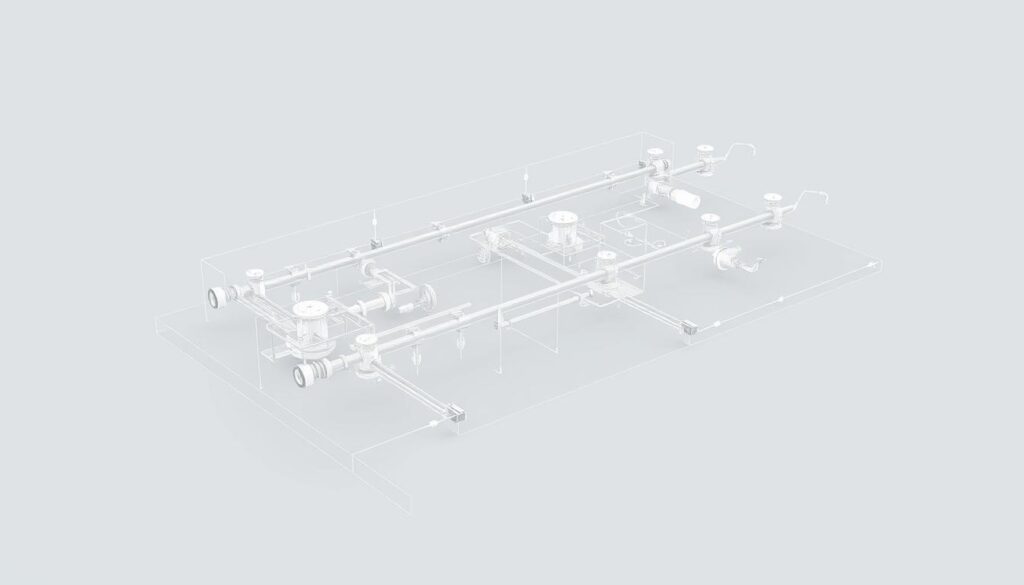Are you aware of the critical role that effective water management plays in modern agriculture and landscaping? With the global push towards sustainability, optimizing water use has become a pressing concern.
The design and implementation of efficient irrigation systems are crucial for conserving this precious resource while ensuring the health and productivity of crops and landscapes.
This guide provides a comprehensive overview of irrigation engineering, covering the principles of water management solutions and the step-by-step process of designing an effective irrigation system.
Key Takeaways
- Understanding the basics of irrigation engineering
- Principles of effective water management solutions
- Step-by-step guide to designing an irrigation system
- Best practices for implementing drip irrigation systems
- Strategies for optimizing irrigation water management
Understanding Irrigation Engineering
As a vital component of agricultural development, irrigation engineering plays a significant role in enhancing crop yields and water management. It involves the application of engineering principles to design, implement, and manage systems that supply water to crops.
Definition and Importance
Irrigation engineering is defined as the application of engineering principles to the design, construction, and management of irrigation systems. Its importance cannot be overstated, as it enables farmers to control water supply, reduce dependence on rainfall, and increase crop productivity. According to recent advancements in agricultural engineering, irrigation engineering has become a cornerstone of modern agriculture.
The significance of irrigation engineering lies in its ability to support sustainable irrigation practices, which are crucial for water conservation and efficient use of this precious resource. By adopting advanced irrigation technologies, farmers can minimize water waste and optimize water application.
Historical Background
The history of irrigation engineering dates back thousands of years, with ancient civilizations developing simple irrigation systems to support agriculture. Over time, the field has evolved significantly, driven by advances in technology and changing agricultural practices.
Historically, irrigation systems were developed using local materials and simple techniques. However, with the advent of modern technology, irrigation engineering has become more sophisticated, incorporating advanced materials, precision agriculture, and automation.
Key Principles
The key principles of irrigation engineering revolve around the efficient distribution and management of water resources. This includes understanding soil-water-crop relationships, selecting appropriate irrigation methods, and designing systems that minimize water loss.
Effective irrigation engineering also involves considering factors such as crop water requirements, soil type, and climate. By applying these principles, farmers and irrigation engineers can develop systems that support sustainable agricultural practices and enhance crop productivity.
Types of Irrigation Systems
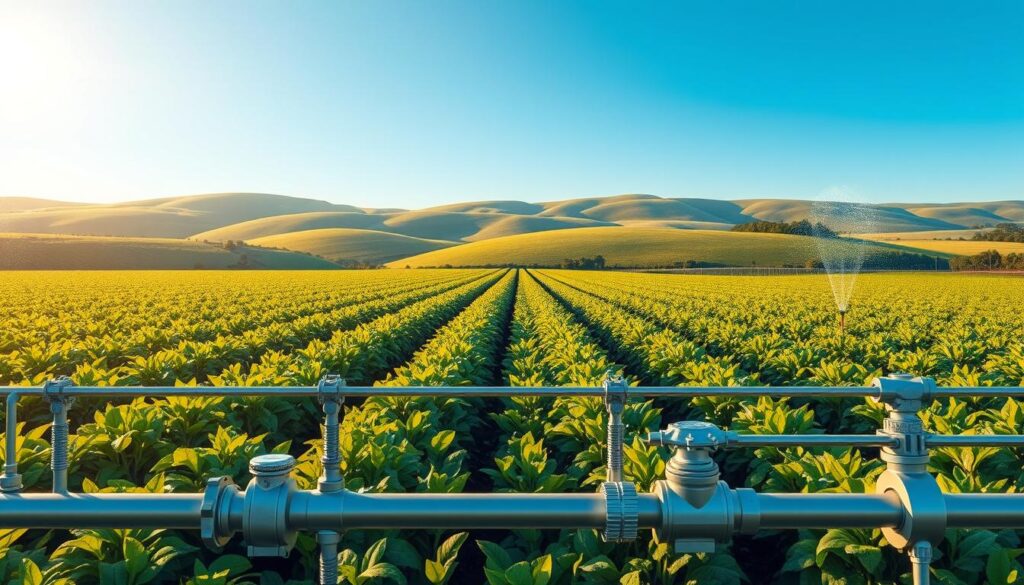
Selecting the right irrigation system is a critical decision that affects not only the health of crops but also the conservation of water resources. The choice of irrigation system significantly influences crop yield, water usage, and overall agricultural productivity.
Surface Irrigation
Surface irrigation involves applying water to the surface of the soil, which then flows over the land by gravity. This traditional method is widely used due to its simplicity and low initial cost. However, it can be less efficient due to potential water loss through runoff and evaporation.
Advantages: Low initial investment, simple to implement.
Disadvantages: Potential for water loss, requires careful land leveling.
Drip Irrigation
Drip irrigation delivers water directly to the roots of plants, reducing evaporation and runoff. This method is highly efficient, especially in arid regions, and can lead to significant water savings. Modern drip irrigation systems can be complex and require precise design and installation.
Efficient water use is a hallmark of drip irrigation, making it an attractive option for water-conscious farmers and landscapers.
Sprinkler Irrigation
Sprinkler irrigation systems distribute water through a network of pipes and sprinklers, mimicking rainfall. This method is versatile and can be used for a variety of crops and landscapes. Sprinkler systems can be fixed or mobile, and their design must consider factors like soil type, crop water requirements, and wind conditions.
For more information on different types of irrigation systems, including sprinkler irrigation, visit this resource that provides detailed insights into various irrigation techniques.
Subsurface Irrigation
Subsurface irrigation involves delivering water directly to the root zone of plants through buried pipes or tubes. This method minimizes evaporation and runoff, making it highly efficient. Subsurface irrigation is particularly useful for crops with deep root systems and can be used in areas with limited water resources.
The design of subsurface irrigation systems requires careful consideration of soil properties and crop water needs to ensure optimal performance.
Planning an Irrigation System
The foundation of a successful irrigation system lies in thorough planning. Effective planning involves several key factors that directly impact the efficiency and productivity of the irrigation system.
Assessing Water Resources
Assessing available water resources is the first step in planning an irrigation system. This involves evaluating the quantity and quality of water available for irrigation. Water management solutions play a critical role in ensuring that water is used efficiently.
Factors such as water source (surface or groundwater), water rights, and potential environmental impacts must be considered. Advanced agricultural irrigation technology can help in optimizing water use.
Soil Type Consideration
Understanding the soil type is crucial for designing an effective irrigation system design. Different soils have varying water-holding capacities and infiltration rates, which affect how water is absorbed and retained.
For instance, sandy soils require more frequent watering due to their low water-holding capacity, while clay soils may require less frequent watering but with a higher volume to avoid waterlogging.
Crop Requirements
Crop water requirements vary significantly depending on the crop type, growth stage, and climatic conditions. It’s essential to determine the specific water needs of the crops being irrigated.
This involves understanding the crop’s water stress tolerance and the optimal moisture levels for maximum yield. Crop selection and rotation can also impact irrigation planning.
Climate Factors
Climate plays a significant role in determining irrigation needs. Factors such as temperature, humidity, wind speed, and precipitation patterns must be considered when planning an irrigation system.
Climate-smart irrigation practices can help in adapting to changing weather conditions and improving water use efficiency.
By carefully assessing water resources, understanding soil types, determining crop water requirements, and considering climate factors, farmers and irrigation engineers can develop effective irrigation plans that maximize water use efficiency and crop productivity.
Designing an Irrigation System
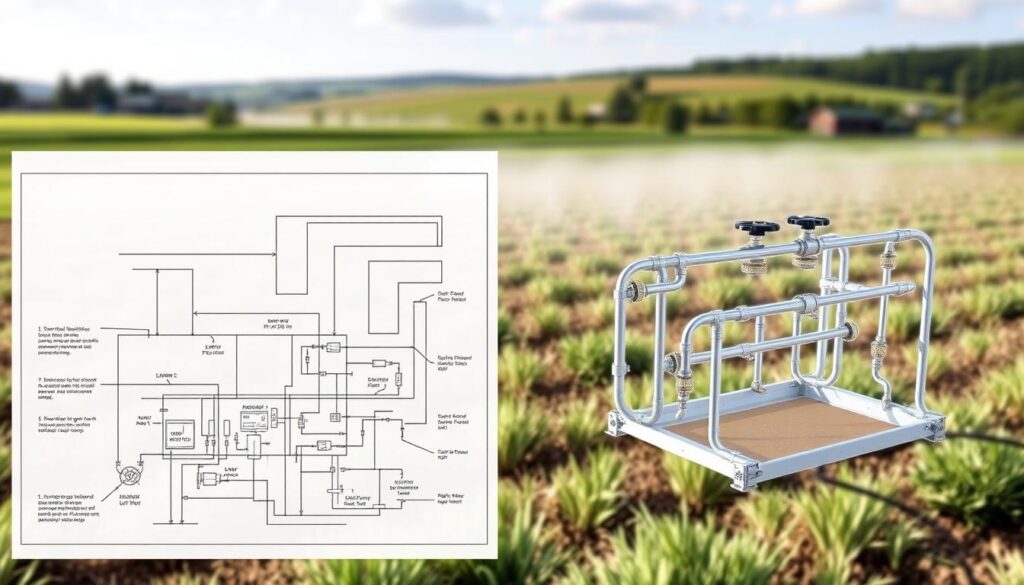
The process of designing an irrigation system involves several key steps that ensure efficient water distribution.
System Layout and Design
Creating an effective system layout is the foundation of a successful irrigation design. It involves determining the optimal placement of pipes, sprinklers, and other components to achieve uniform water distribution. Modern irrigation techniques emphasize the use of advanced software and technologies to model and simulate irrigation systems, allowing for more precise design.
According to a study published in the Journal of Irrigation and Drainage Engineering, “the use of computer-aided design (CAD) software has become increasingly prevalent in irrigation system design, enabling engineers to create detailed designs and analyze system performance.”
“CAD software allows for the creation of complex irrigation system designs that can be easily modified and optimized.”
Hydraulic Calculations
Hydraulic calculations are critical in determining the pressure and flow rate requirements of the irrigation system. These calculations help in selecting the appropriate pumps and pipes that can handle the system’s demands. Accurate hydraulic calculations are essential to prevent issues such as inadequate water pressure or excessive energy consumption.
| Component | Description | Considerations |
|---|---|---|
| Pipes | Carry water throughout the system | Material, diameter, pressure rating |
| Pumps | Provide the necessary pressure and flow rate | Type, horsepower, efficiency |
| Sprinklers | Distribute water across the irrigated area | Type, spacing, nozzle size |
Equipment Selection
The selection of equipment for an irrigation system depends on various factors, including the type of crops, soil characteristics, and climate conditions. Irrigation engineering companies often recommend the use of high-quality equipment that is durable and efficient. The choice of pumps, pipes, sprinklers, and controllers should be based on the specific requirements of the irrigation system.
For instance, drip irrigation systems require specialized emitters and tubing that can provide precise water delivery. In contrast, sprinkler irrigation systems need sprinklers that can cover the desired area with the appropriate throw distance and pattern.
Irrigation System Components
The components of an irrigation system play a vital role in its overall performance and water conservation capabilities. Effective irrigation engineering relies on understanding these components and their functions.
Pumps and Pipes
Pumps are essential for creating the pressure needed to distribute water throughout the irrigation system. The type and size of the pump depend on the system’s water requirements and the terrain of the area being irrigated. Pipes, on the other hand, are responsible for transporting water from the pump to the various parts of the system. The material and diameter of the pipes are critical factors in ensuring efficient water delivery and minimizing losses due to friction and leakage.
For more detailed information on the anatomy of a sprinkler system, including pumps and pipes, visit Sprinkler Warehouse’s educational resource.
Valves and Controllers
Valves control the flow of water within the irrigation system, allowing for different sections to be irrigated independently. Controllers, often equipped with timers and sensors, automate the irrigation process, ensuring that water is applied at the right time and in the right amount. Modern controllers can be programmed to adjust for weather conditions, soil moisture levels, and other factors, optimizing water use and reducing waste.
Filters and Emitters
Filters are used to remove debris and contaminants from the water, protecting the irrigation system’s components from clogging and damage. Emitters, typically used in drip irrigation systems, deliver water directly to the roots of plants, reducing evaporation and runoff. The selection of appropriate filters and emitters is crucial for the efficiency and longevity of the irrigation system.
By understanding and properly maintaining these components, farmers and landscapers can ensure their irrigation systems operate effectively, conserving water while promoting healthy plant growth.
Water Management Practices
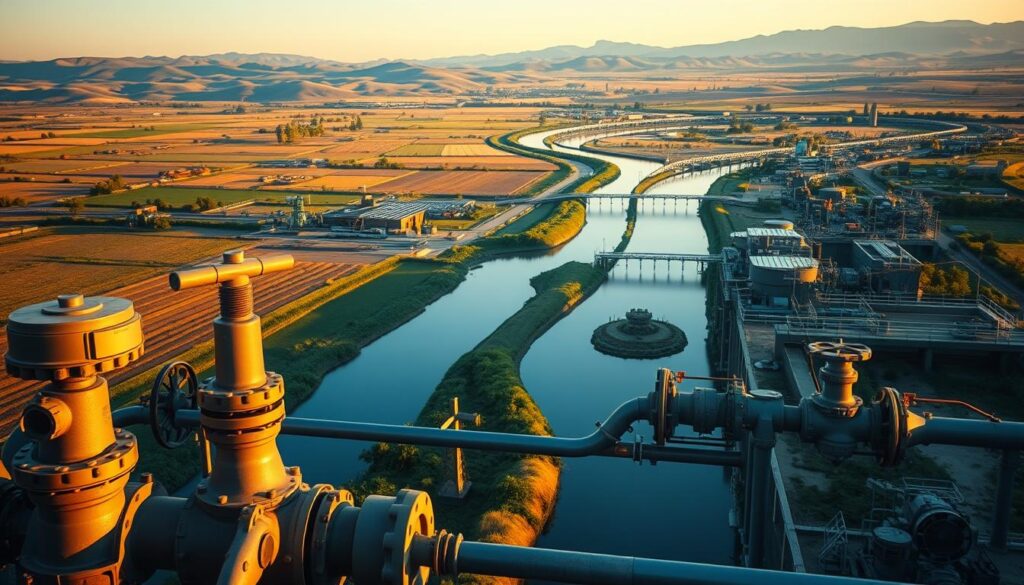
Water management practices play a vital role in the efficiency and sustainability of irrigation systems. Effective water management ensures that crops receive the right amount of water at the right time, thereby optimizing water use and reducing waste.
Scheduling Irrigation
Scheduling irrigation is a critical component of water management. It involves determining the optimal time and amount of water to be applied to crops. Soil type, crop water requirements, and climate conditions are key factors that influence irrigation scheduling. By using techniques such as soil moisture monitoring, farmers can make informed decisions about when to irrigate.
As noted by irrigation experts, “Understanding the soil’s water-holding capacity and the crop’s water use pattern is essential for developing an effective irrigation schedule.”
“The goal is to supply water when the crop needs it most, without overwatering or underwatering.”
Water Conservation Techniques
Water conservation is an integral part of sustainable irrigation practices. Techniques such as drip irrigation and mulching help reduce water loss due to evaporation and runoff. Additionally, using drought-tolerant crop varieties can further enhance water conservation efforts.
Monitoring Soil Moisture
Monitoring soil moisture is crucial for efficient irrigation management. It helps in assessing the soil’s water status, enabling farmers to adjust their irrigation schedules accordingly. Various tools and technologies, including soil moisture sensors, are available for monitoring soil moisture levels.
By adopting these water management practices, farmers can not only improve the efficiency of their irrigation systems but also contribute to sustainable irrigation practices that conserve water resources for future generations.
Maintenance of Irrigation Systems
Irrigation system maintenance is a multifaceted process that involves several key steps to ensure the system operates efficiently and effectively.
Regular Inspections
Regular inspections are crucial for identifying potential issues before they become major problems. This includes checking for leaks, clogged emitters, and worn-out parts. An irrigation engineering company can provide expert advice on how to conduct these inspections.
During inspections, it’s essential to examine the system’s components, such as pumps, pipes, valves, and controllers. Ensuring that these components are in good working condition is vital for the overall performance of the irrigation system.
Repair Techniques
Once issues are identified, effective repair techniques are necessary to restore the system’s functionality. This may involve replacing damaged parts, cleaning clogged emitters, or fixing leaks. Understanding modern irrigation techniques can help in applying the most appropriate repair methods.
It’s also important to have a maintenance schedule to ensure that repairs are done in a timely manner, minimizing downtime and optimizing water use.
Troubleshooting Common Issues
Troubleshooting is a critical aspect of irrigation system maintenance. Common issues include uneven water distribution, reduced water pressure, and system failures. Knowing how to troubleshoot these problems is essential for maintaining the system’s efficiency.
For instance, if there’s uneven water distribution, checking for clogged or damaged emitters and ensuring that the system’s pressure is adequate can resolve the issue. In cases of system failures, identifying the root cause, whether it’s a faulty pump or a broken pipe, is crucial for effective repair.
By combining regular inspections, effective repair techniques, and prompt troubleshooting, farmers and landscapers can ensure their irrigation systems operate at peak performance, conserving water and reducing costs.
Environmental Impacts of Irrigation
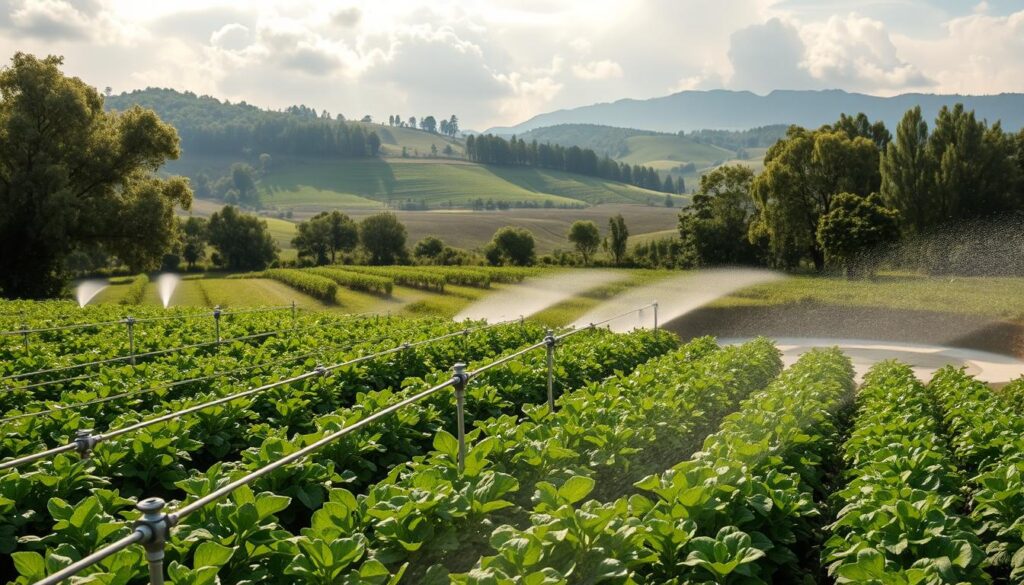
The environmental consequences of irrigation are multifaceted, affecting ecosystems and water quality in various ways. Irrigation, a crucial practice for agriculture, has significant implications for the environment, making it essential to understand and mitigate its impacts.
Effects on Local Ecosystems
Irrigation can alter local ecosystems by changing water tables, affecting biodiversity, and modifying habitats. For instance, excessive irrigation can lead to waterlogging, which can be detrimental to plant growth and alter the local microecosystem.
Impact on Biodiversity: Irrigation can lead to changes in water availability, affecting the local flora and fauna. This can result in a loss of biodiversity as some species may not adapt to the changed conditions.
Water Quality Considerations
Irrigation affects water quality through various mechanisms, including the leaching of fertilizers and pesticides into water bodies. This can lead to water pollution, affecting both human health and the environment.
| Water Quality Parameter | Impact of Irrigation | Mitigation Strategy |
|---|---|---|
| Nitrate Levels | Increased due to fertilizer use | Precision agriculture, reduced fertilizer application |
| Pesticide Residues | Pollution from runoff | Integrated Pest Management (IPM) practices |
| Salinity | Increased salinity from irrigation water | Use of saline-tolerant crops, improved drainage |
Mitigation Strategies
To mitigate the environmental impacts of irrigation, several strategies can be employed. These include adopting sustainable irrigation practices such as drip irrigation, which reduces water waste and minimizes the leaching of chemicals into the soil.
- Implementing water-saving technologies
- Adopting precision agriculture techniques
- Improving irrigation scheduling based on soil moisture monitoring
By adopting these strategies, it’s possible to reduce the environmental footprint of irrigation, ensuring that it remains a viable and sustainable practice for agriculture.
Advancements in Irrigation Technology
Advancements in irrigation technology are revolutionizing agricultural practices worldwide. The integration of modern irrigation techniques is enhancing water use efficiency, reducing labor costs, and improving crop yields.
Smart Irrigation Systems
Smart irrigation systems utilize real-time data and advanced algorithms to optimize water application. These systems can be controlled remotely through mobile apps, allowing farmers to adjust irrigation schedules based on weather forecasts, soil moisture levels, and crop water requirements.
Key Features of Smart Irrigation Systems:
- Real-time monitoring of soil moisture and weather conditions
- Automated adjustment of irrigation schedules
- Remote control through mobile applications
- Data analytics for informed decision-making
Use of Drones and Sensors
The use of drones and sensors in irrigation management is becoming increasingly prevalent. Drones equipped with thermal and multispectral sensors can monitor crop health, detect water stress, and identify areas requiring irrigation.
| Technology | Application | Benefits |
|---|---|---|
| Drones | Crop monitoring, water stress detection | Early detection of issues, targeted irrigation |
| Sensors | Soil moisture monitoring, weather monitoring | Real-time data for irrigation scheduling |
Automated Control Systems
Automated control systems are being adopted to streamline irrigation operations. These systems can automatically adjust valves and pumps based on real-time data from sensors, ensuring that crops receive the right amount of water at the right time.
For more information on how technology is changing irrigation systems, visit 7 Ways Technology Will Change Irrigation.
The future of irrigation lies in the integration of technology and sustainable practices, ensuring water conservation and improved agricultural productivity.
Regulatory Considerations
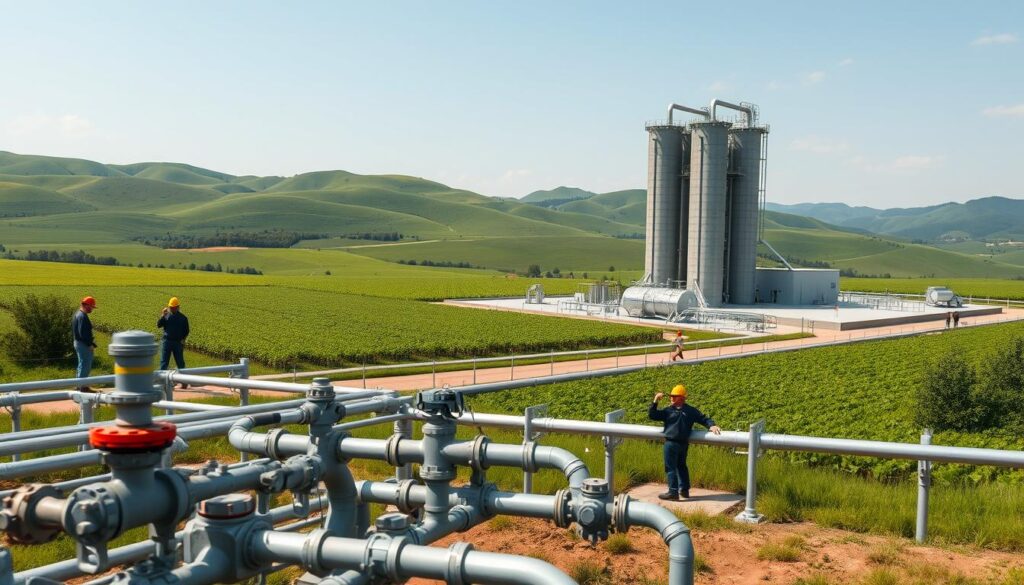
Regulatory considerations play a pivotal role in the design and operation of irrigation engineering projects. Ensuring compliance with relevant laws and regulations is crucial for the sustainability and legality of these projects.
Permitting Requirements
Before initiating an irrigation project, obtaining the necessary permits is essential. The permitting process involves submitting detailed plans and specifications to the relevant authorities. For instance, in the United States, the Electronic Code of Federal Regulations provides guidelines that must be followed.
The specific permits required can vary depending on the project’s location, size, and type. Common permits include water rights permits, environmental impact assessment permits, and construction permits.
Local and Federal Guidelines
Irrigation projects must comply with both local and federal guidelines. Local regulations may dictate specific requirements for water usage, while federal guidelines ensure that projects adhere to national standards for environmental protection and public health.
For example, the U.S. Environmental Protection Agency (EPA) sets standards for water quality that irrigation projects must meet. Compliance with these guidelines is not only legally required but also contributes to the project’s long-term sustainability.
Sustainable Practices
Adopting sustainable practices in irrigation engineering is increasingly important. This includes using water-efficient technologies, implementing conservation measures, and ensuring that water sources are managed responsibly.
Sustainable irrigation practices not only help in conserving water but also reduce the environmental impact of irrigation projects. Techniques such as drip irrigation and the use of soil moisture sensors can significantly enhance water use efficiency.
| Regulatory Aspect | Description | Importance |
|---|---|---|
| Permitting Requirements | Obtaining necessary permits before project initiation | Ensures legal compliance and project viability |
| Local and Federal Guidelines | Adhering to local and national regulations | Ensures environmental protection and public health |
| Sustainable Practices | Adopting water-efficient and conservation measures | Enhances water use efficiency and reduces environmental impact |
Economic Factors in Irrigation Engineering
Economic considerations play a pivotal role in the planning and execution of modern irrigation techniques. The financial viability of irrigation projects is crucial for their success and sustainability.
Cost Analysis and Budgeting
A thorough cost analysis is essential for irrigation system installation. This involves assessing the costs of equipment, labor, and maintenance. An irrigation engineering company must provide a detailed breakdown of these costs to ensure that the project stays within budget.
The costs associated with irrigation system installation can be categorized into initial investment and ongoing expenses. Initial costs include the purchase of equipment and infrastructure, while ongoing expenses cover maintenance, energy, and repair costs.
| Cost Category | Description | Estimated Cost |
|---|---|---|
| Initial Investment | Equipment and Infrastructure | $100,000 |
| Ongoing Expenses | Maintenance and Energy | $10,000/year |
ROI Considerations
Return on Investment (ROI) is a critical factor in determining the economic viability of an irrigation project. An irrigation system installation that is designed and implemented efficiently can significantly enhance crop yields and reduce water waste, thereby improving ROI.
To maximize ROI, it’s essential to consider factors such as water savings, increased crop productivity, and reduced labor costs. A well-designed irrigation system can lead to substantial long-term savings and revenue generation.
Financing Options
Various financing options are available for irrigation engineering projects, including loans, grants, and public-private partnerships. Understanding these options is crucial for irrigation engineering companies to secure the necessary funding.
Government incentives and subsidies can also play a significant role in supporting irrigation projects. These programs can help offset initial costs and improve the overall financial attractiveness of the project.
By carefully evaluating economic factors, including cost analysis, ROI considerations, and financing options, stakeholders can make informed decisions that ensure the success and sustainability of irrigation engineering projects.
Case Studies of Successful Irrigation Projects
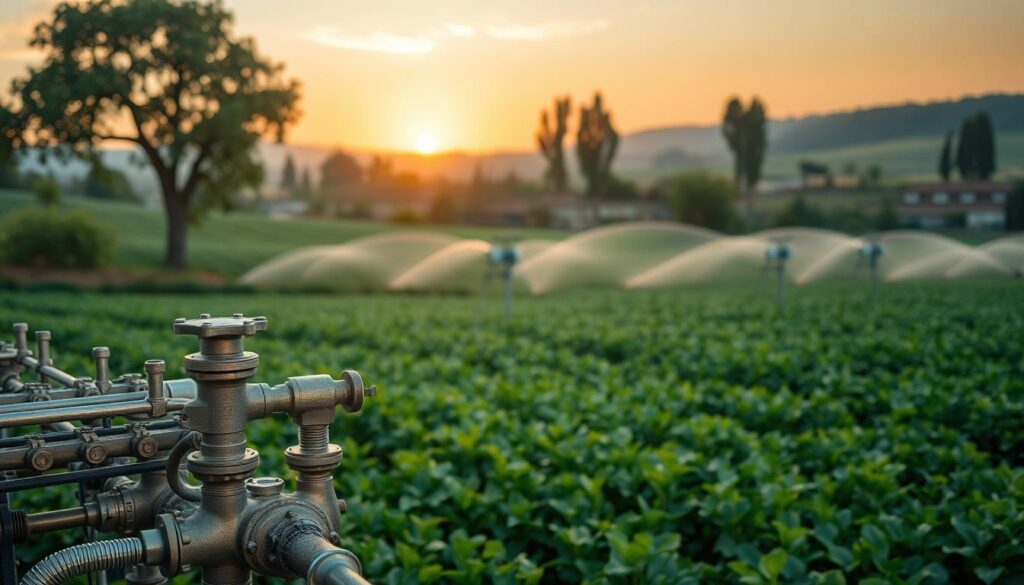
Several successful irrigation projects have demonstrated the effectiveness of sustainable irrigation practices in different parts of the world. These case studies highlight the importance of proper irrigation system design and water management solutions in achieving agricultural productivity and water conservation.
Agricultural Case Study
In a notable agricultural project, the implementation of a drip irrigation system resulted in a significant reduction in water usage while increasing crop yields. This was achieved through careful planning and efficient irrigation system design, taking into account the soil type, crop requirements, and climate factors.
- Water savings of up to 50% compared to traditional flood irrigation methods.
- Increased crop yields due to optimized water application.
- Reduced soil erosion and improved soil health.
Urban Irrigation Example
In an urban setting, a city implemented a smart irrigation system that utilized sensors and automated controls to optimize water usage for landscaping and public spaces. This water management solution not only reduced water consumption but also lowered maintenance costs.
- The system adjusted watering schedules based on weather forecasts and soil moisture levels.
- It included leak detection and alerted maintenance personnel to potential issues.
- The overall water usage was reduced by 30%, contributing to the city’s water conservation goals.
Conservation Efforts
A conservation project focused on restoring a wetland area through sustainable irrigation practices. By designing an irrigation system that mimicked natural hydrological patterns, the project enhanced biodiversity and improved ecosystem services.
| Project Aspect | Outcome |
|---|---|
| Water Management | Improved water retention and reduced runoff. |
| Biodiversity | Enhanced habitat for native species. |
| Ecosystem Services | Improved water quality and increased carbon sequestration. |
These case studies demonstrate the potential of well-designed irrigation systems and sustainable practices to address water management challenges in various contexts.
Future Trends in Irrigation Engineering
Irrigation engineering is on the cusp of a revolution, driven by technological advancements and changing environmental conditions. As the global population continues to grow, the demand for efficient and sustainable irrigation practices is becoming increasingly important.
Innovations for Climate Adaptation
The impact of climate change on water resources is a significant concern. Innovations in irrigation engineering are focusing on climate adaptation strategies, such as:
- Developing drought-resistant crops
- Implementing advanced weather forecasting systems
- Enhancing water storage infrastructure
These innovations are crucial for ensuring the resilience of irrigation systems in the face of climate variability.
Emerging Research Areas
Research in irrigation engineering is expanding into new areas, including the application of:
- Artificial intelligence for predictive maintenance
- Internet of Things (IoT) devices for real-time monitoring
- Precision agriculture techniques for optimized water use
These emerging research areas hold significant promise for improving the efficiency and sustainability of irrigation systems.
The Role of Public Policy
Public policy plays a critical role in shaping the future of irrigation engineering. Governments and regulatory bodies can influence the adoption of new technologies and practices through:
| Policy Instrument | Description | Impact |
|---|---|---|
| Subsidies | Financial incentives for farmers to adopt new irrigation technologies | Increased adoption of efficient irrigation systems |
| Regulations | Standards for water use and irrigation system design | Improved water conservation and reduced environmental impact |
| Research Funding | Grants for research into new irrigation technologies and practices | Advancements in irrigation engineering and increased innovation |
By understanding the interplay between technological innovation, research, and public policy, we can better navigate the future trends in irrigation engineering.
Resources for Further Learning
To deepen your understanding of irrigation engineering and stay updated on the latest developments, several resources are available. These resources span literature, online courses, and professional organizations, all of which can enhance your knowledge and skills in irrigation system design and water management solutions.
Literature and Research
Numerous books and journals offer insights into irrigation engineering. Notable publications include the Journal of Irrigation and Drainage Engineering and textbooks like “Irrigation Engineering” by the American Society of Civil Engineers. These resources provide comprehensive information on irrigation principles, design, and management.
Online Education
Online courses and certifications are available through platforms like Coursera, edX, and the Irrigation Association. These programs cover topics from basic irrigation principles to advanced water management solutions, catering to various levels of expertise in irrigation engineering.
Professional Affiliations
Joining professional organizations such as the Irrigation Association or the American Society of Agricultural and Biological Engineers (ASABE) can provide access to networking opportunities, conferences, and the latest research in irrigation system design and water management.
